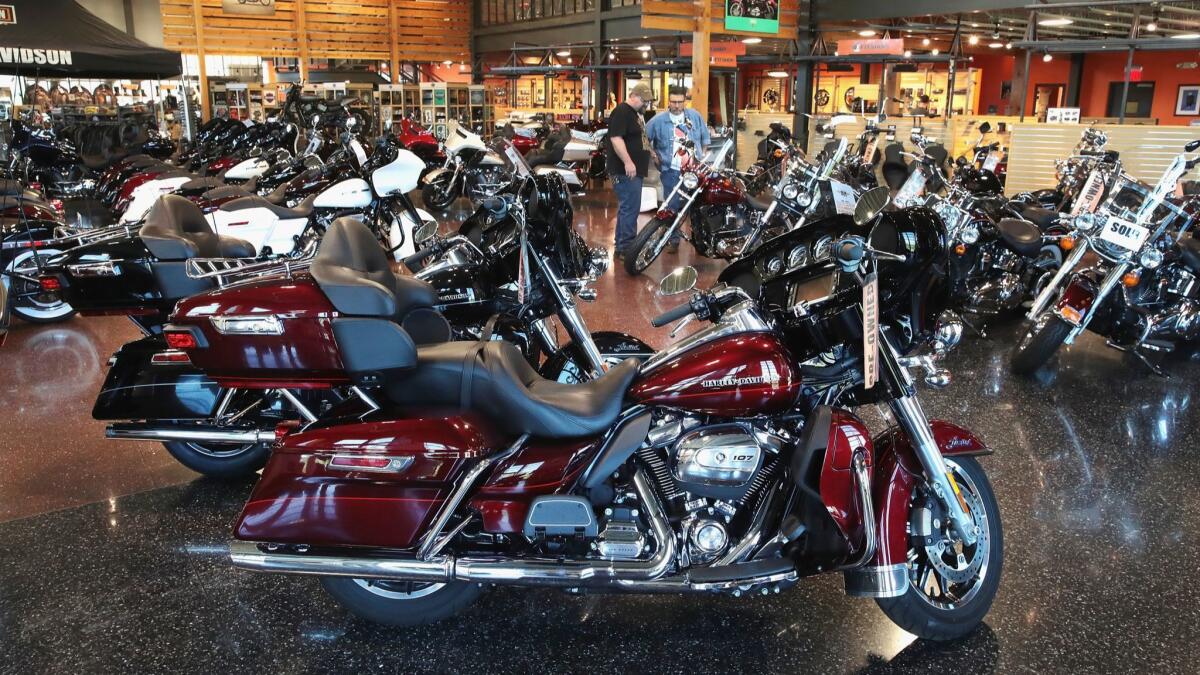Trump’s budget bet piles debt on voters who were promised a pay raise

- Share via
America’s boldest fiscal experiment for half a century is yielding some surprising results, and Donald Trump isn’t done experimenting yet.
The president, who’s promised more tax cuts as his party heads into midterm elections, has already driven the budget into uncharted territory. Several predecessors have injected a bigger stimulus during recessions. But not since Lyndon Johnson was trying to build a Great Society, while also fighting the Vietnam War, has so much deficit-spending been unleashed into a growing economy.
Generosity on that scale is often supposed to please voters, who enjoy a sugar-high in the short term, while terrifying investors who take a longer view. What’s striking about the Trump stimulus so far is that neither of those things appears to be happening.
Bonds have edged lower, and they extended declines on Wednesday when the Treasury said that debt issuance to finance the Trump shortfall is about to surpass levels reached after the 2008 crisis. Still, there’s been no big selloff. By historical standards it remains cheap for the government to borrow.
Meanwhile, fiscal stimulus has juiced the economy — but even the fastest growth in four years hasn’t made Trump’s tax overhaul a hit on the campaign trail, according to internal polling by his own party. By a 2-to-1 margin, respondents said the measures favored large corporations and the rich over ordinary Americans. “We’ve lost the messaging battle,’’ the Republicans concluded.
Trump responded with a new message — one that caught even Republicans off guard and may not materialize anytime soon. He promised an additional 10% income-tax cut, this time targeting the middle class.
December’s reduction in corporate taxes was promoted as a measure that would help all Americans — by boosting their pay. When Trump’s Council of Economic Advisers published a paper defending the plan, it began with the sentence: “Wage growth in America has stagnated.’’
A year later, even with unemployment at the lowest in a half-century, Americans still aren’t getting the kind of pay raises that were commonplace before the Great Recession. Wages rose 2.9% in September, the Labor Department reported Wednesday — the largest hike in nominal terms since 2008, but smaller than increases in 2015 and 2016 once adjusted for inflation.
The resulting economy has a split personality. Both sides are on display in places like Green Bay, Wisc.
In 2016, Trump’s anti-establishment rhetoric played well in the area, where bikers ride Harleys without helmets and love for the Green Bay Packers football team borders on the religious. So did his vow to “make America great again,’’ invoking the broad rise in living standards after World War II. He was the first Republican presidential contender to win the state since Ronald Reagan.
Now, with Wisconsin’s jobless rate near a record low at 3%, business says it’s struggling to find enough labor. “The economy’s humming,’’ says Rob Kleman, a senior vice president at the Oshkosh Chamber of Commerce.
Unleashing animal spirits in boardrooms is one thing. How the proceeds are shared out is another.
Betsy LaFontaine, who works at a call center in nearby Appleton, did get a $1,000 one-time bonus from her employer AT&T Inc. after the tax cuts. But she said it just made her think of former colleagues fired during years of downsizing.
“That money felt really dirty,’’ she said. “It felt like a reward at other people’s expense. All of us would have much preferred a wholesale increase in our wages,’’ or better benefits, or more job security.
Phil Krause, a local entrepreneur who runs the nonprofit Time Community Theater, says there’s no boom-time feel to his town. “Everybody’s hiring, which is good,’’ he says. “But you can work full time in Oshkosh and still be a little bit broke.’’
That disconnect may be one reason Republicans are facing a stiff midterm challenge in Wisconsin.
Gov. Scott Walker is in a close race with Democrat Tony Evers, a former high school principal. Walker has made the state business-friendly along Trumponomic lines, cutting corporate and personal tax rates. Evers proposes to raise the minimum wage and invest more in schools and infrastructure. Democratic Sen. Tammy Baldwin, who’s favored to retain her seat, is calling for an economy that “works for everyone, not just a wealthy few.’’
In the decades before Trump, the distribution of growth steadily shifted in favor of those few, making the U.S. the most unequal economy in the developed world.
Trump critics say he’s amplifying that trend. “Tax cuts only work if you believe in trickle-down economics,’’ says Rakeen Mabud of the Roosevelt Institute, a Treasury official under the Obama administration. “At least 30 years of data shows that it’s more of a trick.’’
But the critics are split over what exactly is wrong with the Trump deficits. Most economists say that so much red ink is dangerous in itself, likely to trigger higher inflation and interest rates. An opposing school argues that there’s room to deficit-spend – it’s just that Trump is doing it in the wrong places, doling out cash to the Pentagon and tax breaks for the wealthy. Expensive programs like universal public healthcare are winning support among Democrats with an eye on 2020.
The president, whose approval rating remains stuck around 40%, will trounce any challenger in two years’ time “if the economy is anywhere close to where it is now,’’ says Stephen Moore, an advisor to Trump in 2016 and co-author of the recent book “Trumponomics.’’ But he acknowledges that there’s an experimental side to what Trump is doing.
“We’re really putting supply-side economics on the line here,’’ says Moore. “If this doesn’t work, we’re going to have to eat some crow.’’
More to Read
Inside the business of entertainment
The Wide Shot brings you news, analysis and insights on everything from streaming wars to production — and what it all means for the future.
You may occasionally receive promotional content from the Los Angeles Times.










